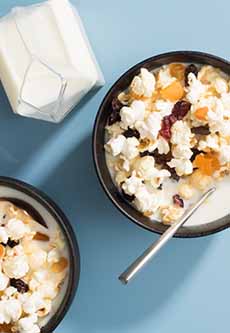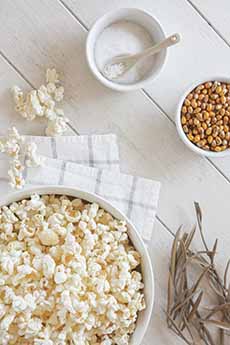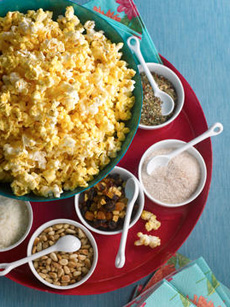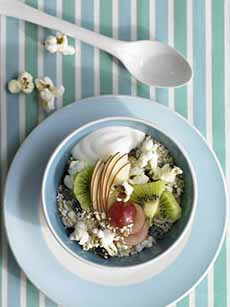Popcorn Breakfast Cereal For National Cereal Day & The History of Cereal
|
|
March 7th is National Cereal Day. Cereal is what Americans eat for breakfast, but in the bigger picture, cereal refers to a group of grasses that are grown for their edible components: grains composed of the endosperm, germ, and bran. They include barley, kamut, maize (corn), millet, oats, rice, rye, sorghum, spelt, teff, triticale, and wheat. Cereal grains are the seeds of the grasses. All are members of the Poaceae family, also called the grasses. It includes the cereal grasses, bamboos, and the grasses of natural grassland and species cultivated in lawns and pasture (the latter two are commonly referred to collectively as grass). The edible cereals divide from the family level into different tribes, genuses, and species. Edible grains from other plant families, such as buckwheat, chia, quinoa, and wild rice, are referred to as pseudocereals. Most cereals are annual plants; one planting yields one harvest. They divide into cool-season cereals (barley, oats, rye, spelt, triticale, and wheat) that cease to grow in and warm-season cereals that are tender and prefer hot weather (maize, millet, rice, sorghum, teff). Cereal grain crops are grown in greater quantities and provide more food energy worldwide than any other type of crop, and are one of the key staple crops*. About 80% of the protein and 50% of the calories consumed by humans and livestock come from cereal grains. The U.S. is a major supplier of cereal grains to the rest of the world [source]. In their natural, unprocessed, whole grain form, cereals are a rich source of vitamins, minerals, carbohydrates, fats, oils, and protein. When processed by the removal of the bran, and germ, the remaining endosperm is mostly carbohydrates. (Here’s more about whole grain cereals.) Popcorn is made from a particular variety of maize (Zea mays var. everta) which expands and puffs up when heated. It’s well-known to Americans as a snack, but Colonial Americans also ate it as a breakfast cereal. Not only is freshly popped popcorn a delicious breakfast cereal; it’s also a whole grain—and it’s food fun, to boot! A recipe follows, as does the history of grains. There are a variety of choices for the topping. Truth to tell, we were out of berries but we had a bag of trail mix. That was our first topping, until we replenished our supply of berries. Thanks to the National Popcorn Board for this recipe. Check their website for many more popcorn recipes. 1. PLACE the popcorn in a bowl and add cold milk, just like any breakfast cereal. 2. SPRINKLE with the optional sugar and top with your choice of stir-ins. Dig in! Cereals were the foundation of human civilization. Most archaeologists and paleoanthropologists agree that agriculture began around 10,000 B.C.E., when nomadic people living near the Tigris and Euphrates Rivers in Mesopotamia (the “Fertile Crescent,” which is modern-day Iraq) settled into villages and began cultivating and breeding wheat. Some believe that the desire for a fixed residence for the growing of wheat was based on the demand for beer. Agriculture produced food that enabled the support of increased populations, leading to larger societies and eventually the development of cities. Since agriculture bred immobility, it led to the accumulation of material goods. And cereals determined how large, and for how long, an army could be mobilized [source]. The word “cereal” is derived from Ceres, the Roman goddess of harvest and agriculture. and grain. The Romans credited her with the discovery of spelt, an ancient strain of wheat, and with the knowledge of how to grow, fertilize and harvest cereal crops. By the early 1700s, the rice and oats had been imported to America from the Old World and were found to be hardy grains for the terrain and climate. Europe’s staple grain, wheat, did not fare well on the East Coast of the continent; wheat flour had to be imported. Maize, which was grown by the Native Americans, became an everyday part of the American diet for bread, breakfast cereal, corn pudding, johnnycakes, and more—even pound cake. The steamroller mill subsequently made it possible to quickly process wheat before it decayed. In the early 19th century, Swedish immigrants began settling in the Midwest, planting wheat and eventually turning the area into a major wheat producer. In 1874, Russian immigrants brought seeds for Turkey Red Wheat to Kansas. It was drought resistant and became a source for many varieties of dwarf wheat grown in the U.S. In 1834 the mechanical revolution in farming began when Cyrus McCormick introduced his mechanical reaper, which allowed two field hands to do the work that had previously taken five to do. In 1847, he patented another important farm implement, a disk plow that facilitated the planting of even rows of cereal grasses. In the 1890s, combine harvesters were introduced. Soon, they would be powered by internal combustion engines and a single farm could harvest almost 20 times as much land as could have been harvested at the outset of the 19th century. That led to efficient corporate farming possible, and the amount of wheat available for the U.S. to export worldwide [source]. While man had boiled cereal grains into porridge since the earliest times, the growth in corn, oat and wheat production led to the packaged breakfast cereals that people worldwide enjoy today. The U.S. is also the world’s top popcorn producer [source]. |
|
|
*A food staple is a food that makes up the dominant part of a population’s diet. They are eaten regularly—some are eaten daily—and supply a major proportion of the populations’ energy and nutritional needs. Cassava, maize, plantains, potatoes, rice, sorghum, soybeans, sweet potatoes, wheat, and yams are some of the leading food crops around the world [source]. †Central Asia is a region in Asia that stretches from the Caspian Sea in the west to China and Mongolia in the east, and from Afghanistan and Iran in the south to Russia in the north. The region consists of the former Soviet republics of Kazakhstan, Kyrgyzstan, Tajikistan, Turkmenistan, and Uzbekistan. East Asia is the eastern region of Asia, which comprises the modern states of China, Japan, Mongolia, North Korea, South Korea, and Taiwan. |
||









